八年级下册英语第一单元教案
- 格式:doc
- 大小:40.50 KB
- 文档页数:6
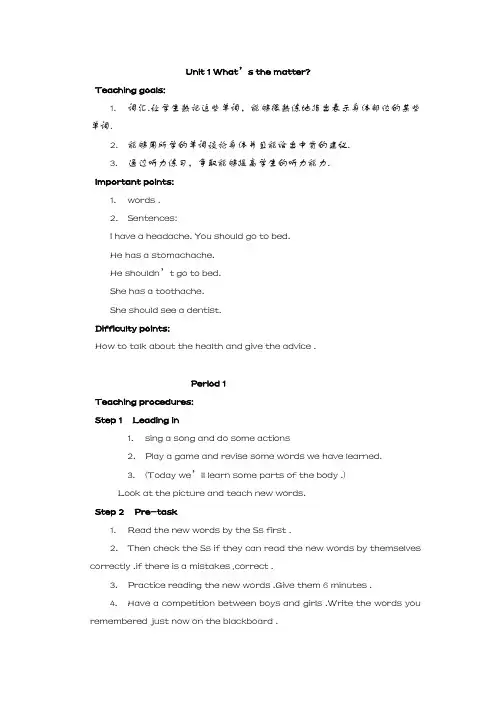
Unit 1 What’s the matter?Teaching goals:1.词汇.让学生熟记这些单词,能够很熟练地指出表示身体部位的某些单词.2.能够用所学的单词谈论身体并且能给出中肯的建议.3.通过听力练习,争取能够提高学生的听力能力.Important points:1.words .2.Sentences:I have a headache. You should go to bed.He has a stomachache.He shouldn’t go to bed.She has a toothache.She should see a dentist.Difficulty points:How to talk about the health and give the advice .Period 1Teaching procedures:Step 1 Leading in1.sing a song and do some actions2.Play a game and revise some words we have learned.3.(Today we’ll learn some parts of the body .)Look at the picture and teach new words.Step 2 Pre-task1.Read the new words by the Ss first .2.Then check the Ss if they can read the new words by themselves correctly .if there is a mistakes ,correct .3.Practice reading the new words .Give them 6 minutes .4.Have a competition between boys and girls .Write the words you remembered just now on the blackboard .Page7, 1a.Do this part by the Ss first. Write the correct letter after the name of each body part on the listPlay a game .All the Ss close your books ,we’ll have a instructor to say :Touch your nose /head /right ear ….Let’s see which student do it correctly and quickly .First all the Ss do this game .Then have competitions between boys and girls .5 boys and 5girls to the front to do what the instructor said .if you are wrong ,please go back to your seats ,the last one who stands at the front is the winner .Step 3 While-task1.Look at the picture and learn the main sentences.A: What’s the matter with you ?B: I have a cold.2. SB Page 7,1c Look at the pictures , work in pairs and act out.3. SB Page 7, 1b .(1) Listen and check the answers .(2) Listen and fill in the blanks.Step 4 Post-task同桌之间设计一个医生与病人之间的对话.Step 5. Exercises in classPeriod 2Teaching procedures :Step 1 Leading in1.Revise : Ask several pairs of students to the front of theclassroom to act out the dialogue:What’s the matter with you ?I have a sore throat.Then ask others : What’s the matter with him/her ?Help Ss answer : He has a sore throat. He should drink lots of water.2.look at pictures and practise the dialogue.Step 2 While-taskSB Page 8, 2a1.Point out the eight items in this activity .Read the item to the class .Ss repeat .2.There are different conversations .Listen carefully . people are talking about health problems they have and getting advice .3.Match the problems with the advice .4.Check the answers .SB Page 8, 2b .Pay attention to the four pictures .1.Each of these pictures illustrates one of the conversations .2.Play the tape ,write the missing words on the blank lines .3.Play the tape again and check the answers .4.Pairwork. Practice reading the dialogues in the pictures .Take turns having the problem and giving the advice .5.Practice reading the dialogue in 2c ,and make their onw conversations .6.Act out the dialogue .SB Page 9, 3a .1.Point out the picture and ask Ss to describe it .(There is a boy sitting on a bench .He’s sick .A teacher is talking to him )2.Pay attention to the dialogue and the blanks in the dialogue .3.Fill in the blanks in the conversation .4.Go over the answers.5.Practice reading the dialogue with a student, then work in pairs . Step 3 Post-taskSB Page 9 , 3b .1.Look at the picture and make your own dialogues setting 3a as an example .2.Act out the dialogue .Ask some pairs to come to the front to act out their onw dialogues .SB Page 9, Part 4. w W w . x K b 1.c o M1.Read the instructions and demonstrate what a “mime”is .2.Read the dialogue by the Ss .3.Ask a student to come to the front and mime an illness ,the other Ss guess what the illness is .4.Ask one student to give advice .5.Give several students an opportunity to come to the front and mime an illness .Step 4Exercises in classHomework1.When you had some problems. Please remember what the doctor said .Remember the new words .Period 3Teaching procedures :Step 1 Leading1.Play the game :One student mimes an illness , the other students guess the illness and give advice .What’s the matter? Do you have a sore throat ?2. Revise how to talk about health and give advice.Step 2 Pre-taskSB Page 10 ,1a .1.Look at the picture .Point out the four new words and expressions .Say each word and ask Ss to repeat .2.The first picture .Explain something about it using one of the four words and expressions .3.Match the words with the pictures by the Ss .4.Check the answers .5.Practice reading and make sure the Ss understand the meaning of the words .SB Page 10 ,1b1.Read the four sentences ,Ss practice reading .2.Look at the picture and match each picture with advice.3.Check the answerStep 3 While-taskSB Page 10 ,2a & 2b .1.First ,make sure the Ss understand what they will hear .2.Then read the four names3.Listen and write the problems on the bland lines .If possible ,write what each person “should”and “shouldn’t”do for their problem.4.Check the answers .Step 4 Post-taskSB Page 10,2c .1.Ask two students to read the conversation to the class .2.Pairwork .Make conversations with your partner .3.Act out the conversations for the class .4.Write two dialogues in the exercise book .5.Exercises in classPeriod 4Teaching procedures :Step 1 LeadingDiscussion: how to keep healthy.Step 2 While taskSB Page 11, 3a1.Read the article and fill in the form.2.Check the answers .3.Explanation4.ExercisesStep 3 Post taskSB Page 11, 3bLet the Ss read the paragraph and fill in the blanks .Check the answers .SB Page 11 ,Part 4.Play the gamePeriod 5 Self checkSB Page 12 , Part 1 .1.Fill in the blanks on their own .2.Make your own sentences with the words .SB Page 12, Part 2.Read the letter .Make sure Ss can understand it . Step 6 Homework1.Remember the words in this unit .2. Do the exercises on Pages 6-8of the workbook . 【课后反思】Unit 2 I’ll help clean up the city parksUnit 2 Section A 1a-Grammar Focus【学习目标】1.重点词汇用法及短语动词用法。
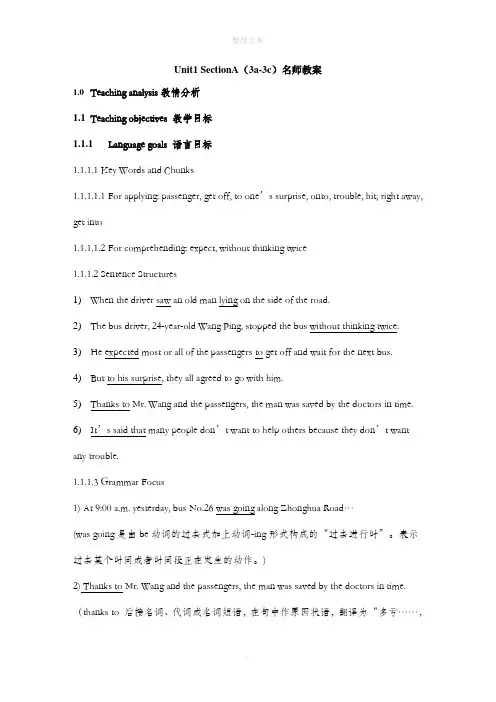
Unit1 SectionA(3a-3c)名师教案1.0Teaching analysis教情分析1.1Teaching objectives 教学目标1.1.1Language goals 语言目标1.1.1.1 Key Words and Chunks1.1.1.1.1 For applying: passenger, get off, to one’s surprise, onto, trouble, hit, right away, get into1.1.1.1.2 For comprehending: expect, without thinking twice1.1.1.2 Sentence Structures1)When the driver saw an old man lying on the side of the road.2)The bus driver, 24-year-old Wang Ping, stopped the bus without thinking twice.3)He expected most or all of the passengers to get off and wait for the next bus.4)But to his surprise, they all agreed to go with him.5)Thanks to Mr. Wang and the passengers, the man was saved by the doctors in time.6)It’s said that many people don’t want to help others because they don’t want any trouble.1.1.1.3 Grammar Focus1) At 9:00 a.m. yesterday, bus No.26 was going along Zhonghua Road…(was going是由be动词的过去式加上动词-ing形式构成的“过去进行时”。
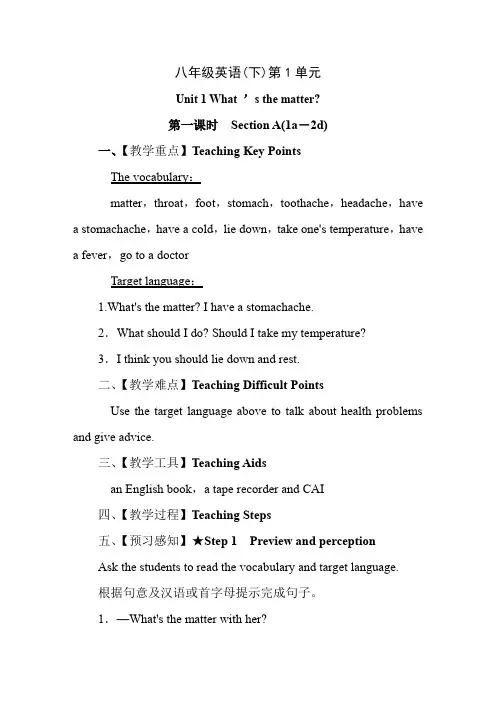
八年级英语(下)第1单元Unit 1 What ’s the matter?第一课时Section A(1a-2d)一、【教学重点】Teaching Key PointsThe vocabulary:matter,throat,foot,stomach,toothache,headache,have a stomachache,have a cold,lie down,take one's temperature,have a fever,go to a doctorTarget language:1.What's the matter? I have a stomachache.2.What should I do? Should I take my temperature?3.I think you should lie down and rest.二、【教学难点】Teaching Difficult PointsUse the target language above to talk about health problems and give advice.三、【教学工具】Teaching Aidsan English book,a tape recorder and CAI四、【教学过程】Teaching Steps五、【预习感知】★Step 1Preview and perceptionAsk the students to read the vocabulary and target language.根据句意及汉语或首字母提示完成句子。
1.—What's the matter with her?—She has a very sore t______ now.2.He ate too much,so he had a s______.3.If you feel tired,you should l______ down and rest.4.If you ______(咳嗽),drink some hot tea with honey.5.He wants to see a dentist,because he has a ______(牙疼).★Step 2Consociation and exploration【合作探究】Let the students read the book by themselves in order to find out the answers.They can discuss the questions in groups or ask the teacher for help.When they finish the questions,ask some students to check the answers.★Step 3Leading in【情景导入】Ask a student to act something is wrong with his/ her head…And T:What's the matter?Help the students to answer:I have a…Have the students repeat.★Step 4Pre-task【准备任务】Page 1,1a &1b1.Look at the picture.Write the correct letter [a-m] for each part of the body.2.Match each activity.3.Play the tape and ask the students to listen and find the answers.Page 1,1c1.Focus on the conversation in the box.2.Practice reading.3.Pairwork:Ask the students to look at the picture and practice in pairs like this:S1:What's the matter?S2:I have…4.Groupwork: Divide the class into some groups.Make conversations.S1:What's the matter?S2:She talked too much yesterday and didn't drink enough water.She has a very sore throat now.S3:…★Step 5While-task【过程任务】Page 2,2a&2b1.Play the recording for the first time.Students listen and number the pictures [1-5] in order.2.Check the answers.3.Play the recording a second time and say:There are five conversations.Some have some problems and the others give them some advice.Listen and match the problems with the advice.★Step 6Post-task【后续任务】Page 2,2c & 2d1.Focus on the conversation in 2c & 2d.2.Practice reading.Make the students scan the conversations first.3.Teach and then make the students role-play the conversation in pairs.4.Play the recording and ask the students to listen and repeat 2d.★Step 7Consolidation practice【巩固练习】Look at the students' book of the 1st exercise.★Step 8Summary【课堂小结】In this class we should master “matter,stomach,toothache,headache,have a stomachache,have a cold,take one's temperature”and some sentences in target language.★Step 9Homework【家庭作业】1.Listen to the tapes twice.2.Practice the conversation on Page 2,2d.Board Design板书设计Unit 1What's the matter?The first period Section A(1a-2d)1.Key vocabulary:have a stomachache;have a cold; lie down;take one's temperature;have a fever;go to a doctor2.Target language:(1)What's the matter? I have a stomachache.(2)What should I do? Should I take my temperature?(3)I think you should lie down and rest.。
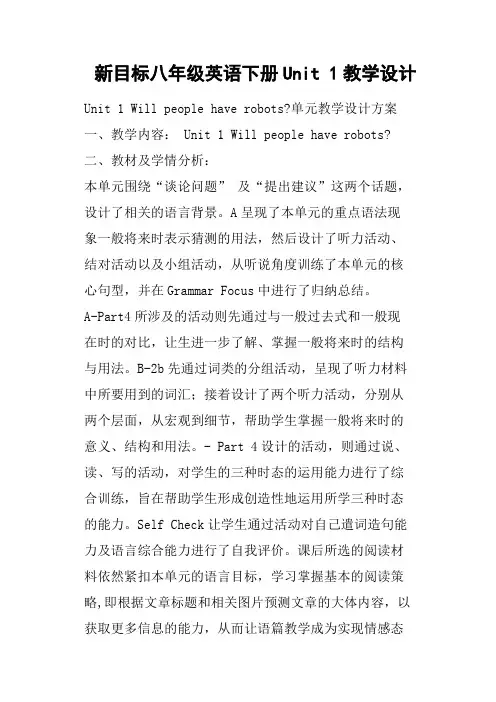
新目标八年级英语下册Unit 1教学设计Unit 1 Will people have robots?单元教学设计方案一、教学内容: Unit 1 Will people have robots?二、教材及学情分析:本单元围绕“谈论问题” 及“提出建议”这两个话题,设计了相关的语言背景。
A呈现了本单元的重点语法现象一般将来时表示猜测的用法,然后设计了听力活动、结对活动以及小组活动,从听说角度训练了本单元的核心句型,并在Grammar Focus中进行了归纳总结。
A-Part4所涉及的活动则先通过与一般过去式和一般现在时的对比,让生进一步了解、掌握一般将来时的结构与用法。
B-2b先通过词类的分组活动,呈现了听力材料中所要用到的词汇;接着设计了两个听力活动,分别从两个层面,从宏观到细节,帮助学生掌握一般将来时的意义、结构和用法。
- Part 4设计的活动,则通过说、读、写的活动,对学生的三种时态的运用能力进行了综合训练,旨在帮助学生形成创造性地运用所学三种时态的能力。
Self Check让学生通过活动对自己遣词造句能力及语言综合能力进行了自我评价。
课后所选的阅读材料依然紧扣本单元的语言目标,学习掌握基本的阅读策略,即根据文章标题和相关图片预测文章的大体内容,以获取更多信息的能力,从而让语篇教学成为实现情感态度与价值观目标的有效载体,通过描述未来,调动学生学习积极性,发挥想象力,帮助其树立正确的人生观和价值观:只有付出,才有收获。
八年级上Unit 3 What are you doing for vacation? Unit 10 I’m going to be a basketball player. 已经学习了一般将来时,学生已经学会用现在进行时谈论未来的计划,用be going to句型谈论未来的打算。
本单元教材继续学习一般将来时,是上册教材的拓展和延续,即用Will 接动词原形来表示将来要发生的动作,让学生学会预测未来,从语法层面上来讲应该顺理成章。
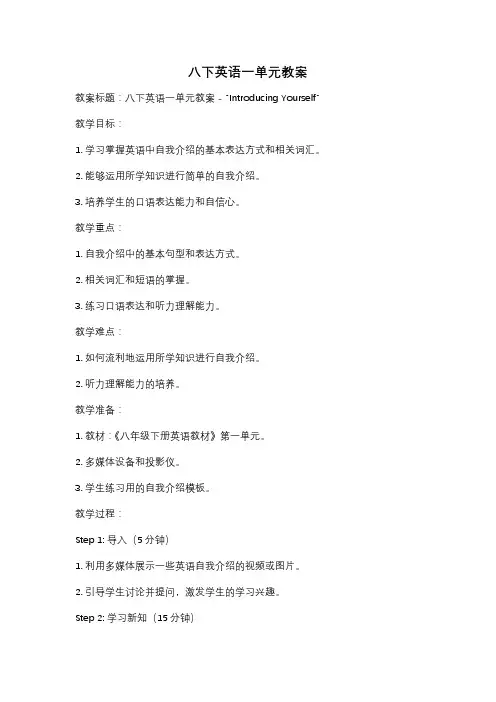
八下英语一单元教案教案标题:八下英语一单元教案 - "Introducing Yourself" 教学目标:1. 学习掌握英语中自我介绍的基本表达方式和相关词汇。
2. 能够运用所学知识进行简单的自我介绍。
3. 培养学生的口语表达能力和自信心。
教学重点:1. 自我介绍中的基本句型和表达方式。
2. 相关词汇和短语的掌握。
3. 练习口语表达和听力理解能力。
教学难点:1. 如何流利地运用所学知识进行自我介绍。
2. 听力理解能力的培养。
教学准备:1. 教材:《八年级下册英语教材》第一单元。
2. 多媒体设备和投影仪。
3. 学生练习用的自我介绍模板。
教学过程:Step 1: 导入(5分钟)1. 利用多媒体展示一些英语自我介绍的视频或图片。
2. 引导学生讨论并提问,激发学生的学习兴趣。
Step 2: 学习新知(15分钟)1. 通过多媒体展示自我介绍的基本句型和表达方式。
2. 解释并讲解相关词汇和短语的意思和用法。
3. 分角色进行对话练习,模拟自我介绍的场景。
Step 3: 练习与巩固(20分钟)1. 学生分组进行自我介绍的练习,互相评价并提出改进建议。
2. 老师进行示范,给予学生指导和反馈。
3. 利用多媒体播放自我介绍的听力材料,让学生进行听力理解练习。
Step 4: 拓展与应用(10分钟)1. 学生分组进行小组讨论,结合所学内容,设计一个自己独特的自我介绍。
2. 鼓励学生展示自己的创造力和表达能力。
Step 5: 总结与反馈(5分钟)1. 老师进行总结,强调学生在自我介绍中需要注意的要点。
2. 学生进行自我评价,反思自己在学习过程中的不足和进步。
教学延伸:1. 布置作业:要求学生用英语写一篇关于自己的短文,并准备下节课进行口头展示。
2. 鼓励学生多参与英语角或其他英语实践活动,提高口语表达和听力理解能力。
教学评估:1. 教师观察学生在课堂练习中的表现,包括口语表达和听力理解。
2. 学生之间进行互评和自评,评价自己在练习中的表现和进步。
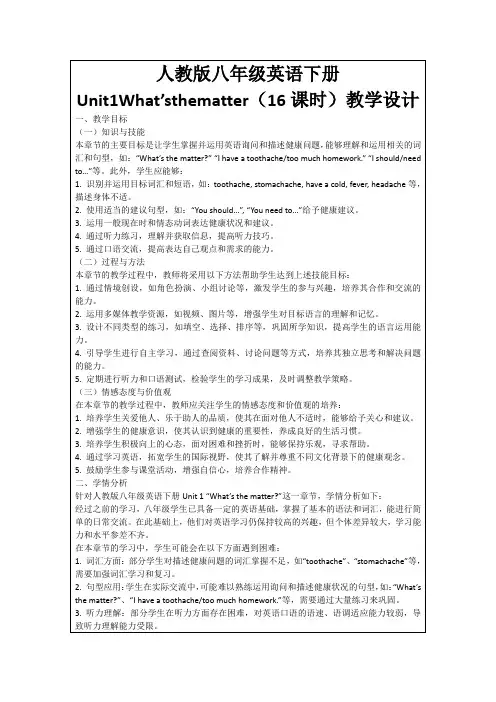
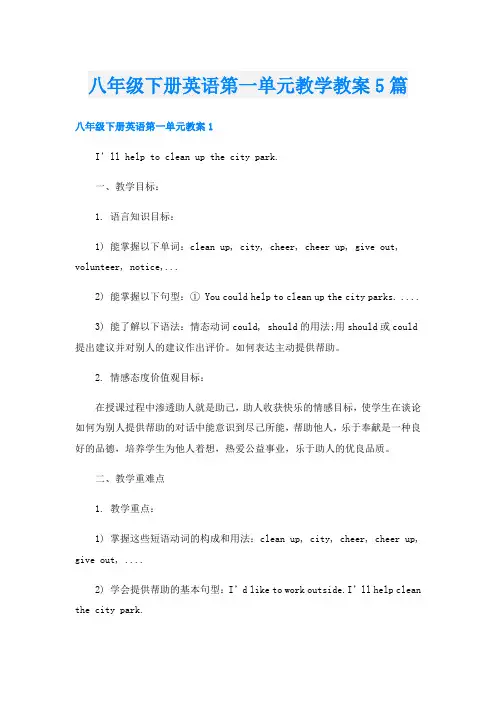
八年级下册英语第一单元教学教案5篇八年级下册英语第一单元教案1I’ll help to clean up the city park.一、教学目标:1. 语言知识目标:1) 能掌握以下单词:clean up, city, cheer, cheer up, give out, volunteer, notice,...2) 能掌握以下句型:① You could help to clean up the city parks. ....3) 能了解以下语法:情态动词could, should的用法;用should或could 提出建议并对别人的建议作出评价。
如何表达主动提供帮助。
2. 情感态度价值观目标:在授课过程中渗透助人就是助己,助人收获快乐的情感目标,使学生在谈论如何为别人提供帮助的对话中能意识到尽己所能,帮助他人,乐于奉献是一种良好的品德,培养学生为他人着想,热爱公益事业,乐于助人的优良品质。
二、教学重难点1. 教学重点:1) 掌握这些短语动词的构成和用法:clean up, city, cheer, cheer up, give out, ....2) 学会提供帮助的基本句型:I’d like to work outside.I’ll help clean the city park.2. 教学难点:学会提供帮助的基本句型三、教学过程Period 1(Section A 1a-2d)Step 1 Warming up1. 播放学生志愿者进行义务帮助别人的活动视频,通过询问他们以下问题来引导学生们了解社会上一些的志愿们进行的活动。
Step 2 New words Read new words on p9-10.Step 3 Discussion1. 1a. Look at the ways you could help others. Then list other ways.2. Ss discuss with their partners and write the ways one could help others:① Help plant trees by the river. ② Help clean up the city park.③ Visit the old people in the old people’s home. ④ Help young kids to learn English.Step 4 Listening1. T: Tell Ss to read the sentences in the chart. Make sure they know the meaning of the sentences.2. 1b. Play the recording for the Ss to listen and number the ways the boy and girl could help others.Step 5 Pair work1. Let Ss read the conversation in the picture.2. 1c. Use the information in the chart of 1b to make other conversations.A: I hope to work outside.B: You could help to clean up the city parks. ........3. Let some pairs act out their conversations.Step 6 Listening1. 2a:T: A group of students are planning a City Park Clean-up Day. Listen and check (√) the things they are going to do to tell people about it.1. Look at the pictures in 2a. Discuss the things they are going to do.2. Play the recording for the Ss to listen and check the pictures.3. Play the recording again to check the answers.2. 2b:1. Let Ss read the sentences below. Explain some main sentences for the Ss. Make sure they know what to do.2. Play the recording for the Ss to write the correct words in the blanks.3. Play the recording again to check the answers.Step 7 Pair work1. 2c. Tell Ss to make a conversation using the information in 2a and 2b.2. Let one pair to read out thei r conversation first.e.g. A: We need to come up with a plan for the City Park Clean-Up Day.B: Let’s have lunch first.A: No, we need to start now. Clean-Up Day is only two weeks from now.B: You’re right. We can’t put off making a plan. As we talk, I’ll write down all our ideas. Then we can decide which ideas are best.A: Let’s make some notices, too. Then I’ll hand them out after school.B: And we could each call up ten students and ask them to come.3. Ss act the conversation in pairs. Ask some pairs to act out their con versations.Step 8 Reading and Role-play1. Read the conversations and answer the two questions:① Where’s Helen going to work this summer?__________________________________② What did Tom do to help the old people?____________________________________Answers: She’s going to work in an old people’s home.Reading the newspaper or just talking to the old people.2. Read the conversation after the teacher.3. Practice the conversation with their partner. Then let some pairs to act out the conversation.Homework:Teaching thought:Period 2(Section A 3a-3c)Step 1 Revision1. Write down the phrases.1. 打扫 ________2. 分发 ________3. 曾经 _______4. (使)变得高兴 ________5. 义务做某事 _________________6. 大打扫日 ______________7. 想出主意(办法)____________2. Role-playA: Hi, Tom. I’m making some plans to work in an old people’s home this summer.B: Really? I did that last summer!Step 2 New words Read new words on p11.Step 3 Reading1.Tell Ss to read the article in 3a quickly and try to find the answers to these questions:1. What does Mario love?2. What does Mary love?3. What do Mario and Mary volunteer to do?Ss read the article quickly and try to answer the questions:Answers: 1. He loves animals.2. She loves reading books.3. Mario volunteers at animal hospital and Mary helps kids learn to read.2.3b: Read the article again and answer the questions.1. Why does Mario volunteer to help others?2. Why does Mary volunteer to help others?3. What does Mario say about volunteering?4. What does Mary say about volunteering?Answers: 1. Because he believes it can help him to get his future dream job.2. Because she can do what she loves to do and help others.3. He gets such a strong feeling of satisfaction when he sees the animals get better and the look of joy on their owners’ face.4. Volunteering is a dream come true for her.Homework Make sentences with these words.help (to) do; want to do; learn to do; decide to do; how to do; volunteer to doTeaching thought:Period 3(Grammar Focus-4c)Step 1 RevisionComplete the sentences.Mario and Mary ____ ___ several hours each week __ ____ others. Mario wants __ ___ an animal doctor. He _________ at an animal hospital. He wants __ _____ more about ____ __ care for animals.Mary is a book lover. She could read by herself __ ___ ____ of four. Last year, she decided __ ___ ___ for a volunteer after-school _______ program. Mary still works there once a week __ ____ kids _____ __ read. Volunteering here is a dream come true for her. She can what she _____ ___ ___and helps others at the same time.Can you tell something about Mary to us?Answers: give up, to help, to be, volunteers, to learn, how to, at the age, to try out, reading, to help, learn to, loves to do Step 2 Grammar focus1. 阅读Grammar Focus中的句子,然后做填空练习。
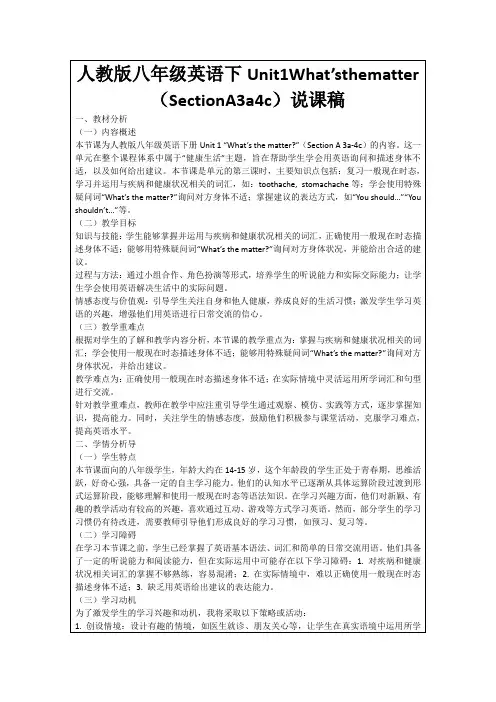
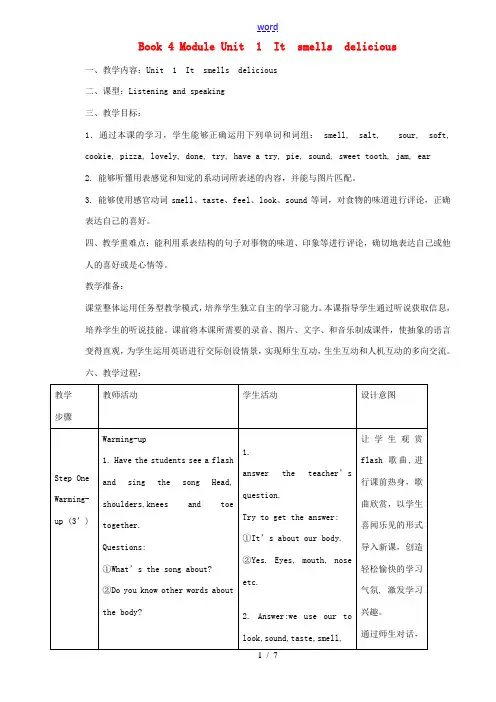
Book 4 Module Unit 1 It smells delicious一、教学内容:Unit 1 It smells delicious二、课型:Listening and speaking三、教学目标:1.通过本课的学习,学生能够正确运用下列单词和词组: smell, salt, sour, soft, cookie, pizza, lovely, done, try, have a try, pie, sound, sweet tooth, jam, ear2. 能够听懂用表感觉和知觉的系动词所表述的内容,并能与图片匹配。
3. 能够使用感官动词smell、taste、feel、look、sound等词,对食物的味道进行评论,正确表达自己的喜好。
四、教学重难点:能利用系表结构的句子对事物的味道、印象等进行评论,确切地表达自己或他人的喜好或是心情等。
教学准备:课堂整体运用任务型教学模式,培养学生独立自主的学习能力。
本课指导学生通过听说获取信息,培养学生的听说技能。
课前将本课所需要的录音、图片、文字、和音乐制成课件,使抽象的语言变得直观,为学生运用英语进行交际创设情景,实现师生互动,生生互动和人机互动的多向交流。
六、教学过程:达标训练题一. 根据句意和汉语提示完成句子。
1. 这菜闻起来好香啊.The dish _______________.2. 这汤尝起来不新鲜.The soup ______________ fresh.3. 这毛衣摸起来很软很舒服。
The sweater _______________________.4. Children like _______ (小甜饼)very much.5. People should eat less ______ ( 盐 ) everyday.6. Oh. It’s my _______(幸运的)day. I'vepassed the exam.二. 单项选择:1. These flowers ______beautiful. I will buysome for my mother.A. lookB. soundC. hearD. taste2. The air in the countryside smells _______.A. sourB. softC. deliciousD. fresh3. The idea ________ good. We can try it.A. tasteB. tastesC. soundsD. sound4. This game is so interesting, please_____ .A. have a lookB. give upC. have a tryD. try some5. Last Sunday was my mother’s birthday, so I _____ a big meal for her.A. cookB. cooksC. cookedD. is cooking。
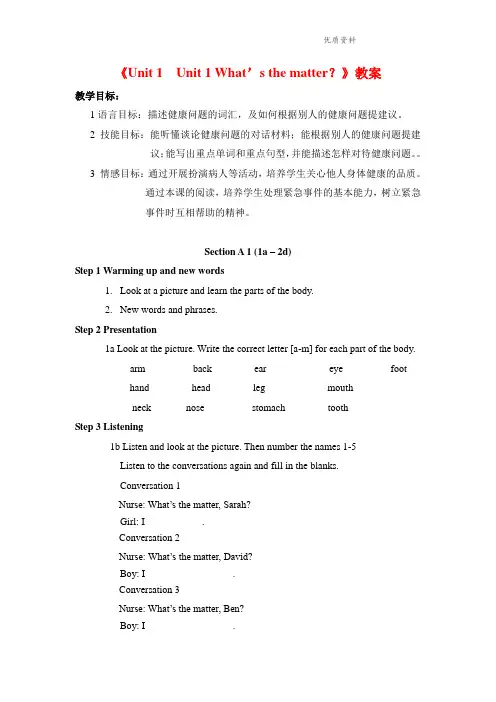
《Unit 1 Unit 1 What’s the matter?》教案教学目标:1语言目标:描述健康问题的词汇,及如何根据别人的健康问题提建议。
2 技能目标:能听懂谈论健康问题的对话材料;能根据别人的健康问题提建议;能写出重点单词和重点句型,并能描述怎样对待健康问题。
3 情感目标:通过开展扮演病人等活动,培养学生关心他人身体健康的品质。
通过本课的阅读,培养学生处理紧急事件的基本能力,树立紧急事件时互相帮助的精神。
Section A 1 (1a – 2d)Step 1 Warming up and new words1.Look at a picture and learn the parts of the body.2.New words and phrases.Step 2 Presentation1a Look at the picture. Write the correct letter [a-m] for each part of the body.___arm ___ back ___ ear ___ eye ___ foot___hand ___ head ___ leg ___ mouth___ neck ___nose ___ stomach ___ toothStep 3 Listening1b Listen and look at the picture. Then number the names 1-5Listen to the conversations again and fill in the blanks.Conversation 1Nurse: What’s the matter, Sarah?Girl: I ___________.Conversation 2Nurse: What’s the matter, David?Boy: I _________________.Conversation 3Nurse: What’s the matter, Ben?Boy: I _________________.Conversation 4Nurse: What’s the matter, Nancy?Girl: I _________________.Conversation 5Betty: What’s the matter, Judy?Ann: She __________________.Step 4 Speaking1c Look at the pictures. What are the students’ problems? Make conversati ons.ExamplesA: What’s the matter with Judy?B: She talked too much yesterday and didn’t drink enough water.She has a very sore throat now.A: What’s the matter with Sarah?B: She didn’t take care of herself on the weekend. She was p laying withher friends at the park yesterday. Then it got windy, but she didn’t puton her jacket. Now she has a cold.Step 5 Guessing gamesGuess what has happened to the students by using the important sentenc es. Step 6 Listening2a Listen and number the pictures [1-5] in the order you hear them.2b Listen again. Match the problems with the advice.Step 7 Speaking2c Make conversations using the information in 2a and 2bA: What’s the matter?B: My head feels very hot.A: Maybe you have a fever.B: What should I do?A: You should take your temperature.Step 8 Role–playImagine you are the school doctor. A few students have health problems.Role-play a conversation between the doctor and the students.2d Role –play the conversationStep 9 Language points and summary1. What’s the matter?这是人们特别是医生和护士询问病人病情时最常用的问句, 意思是“怎么了?”其后通常与介词with连用。
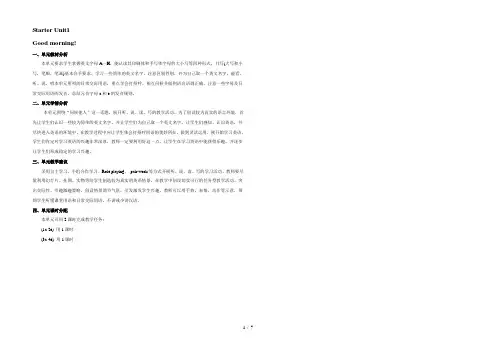
Starter Unit1Good morning!一、单元教材分析本单元要求学生掌握英文字母A—H,能认读其印刷体和手写体字母的大小写等四种形式。
书写(大写和小写,笔顺,笔画)基本合乎要求。
学习一些简单的英文名字,注意区别性别,并为自己取一个英文名字。
能看、听、说、唱本单元所列的日常交际用语,重点学会打招呼、相互问候并做到语音语调正确。
注意一些字母及日常交际用语的发音,总结元音字母a和e的发音规则。
二、单元学情分析本单元围绕“问候他人”这一话题,展开听、说、读、写的教学活动。
为了创设较为真实的语言环境,首先让学生们认识一些较为简单的英文名字,并让学生们为自己取一个英文名字,让学生们感知、认识英语,并尽快进入英语的环境中。
在教学过程中应让学生体会打招呼用语的奥妙所在,做到灵活运用。
刚开始学习英语,学生们肯定对学习英语的兴趣非常深厚,教师一定要利用好这一点,让学生在学习英语中能获得乐趣。
并逐步让学生们形成稳定的学习兴趣。
三、单元教学建议采用自主学习、小组合作学习、Role playing、pair work等方式开展听、说、读、写的学习活动。
教师要尽量利用幻灯片、挂图、实物等给学生创造较为真实的英语情景。
在教学中创设切实可行的任务型教学活动、突出交际性。
引趣激趣策略,创设情景调节气氛,引发激发学生兴趣。
教师可以用手势,表情,动作等示意,帮助学生听懂课堂用语和日常交际用语,不讲或少讲汉语。
四、单元课时分配本单元可用2课时完成教学任务:(1a-2e) 用1课时(3a-4d) 用1课时(1a-2d)一、教学目标:1. 语言知识目标:1) 能掌握以下词汇:字母Aa ~ Hh, good, morning, Good morning!, hi, hello2) 能掌握以下句型:①Good morning, Helen!②Hello, Frank!③Hi, Bob!3) 能理解用英语打招呼的不同说法,并能灵活运用。
Unit1What's the matter?第一课时Section A(1a2d)【教学目标】1.重点单词:matter,back,sore,throat,stomachache,foot,neck,stomach,fever,lie,rest,cough,X ray,toothache,headache 2重点短语:have a sore throat,have a stomachache,have a cold,lie down,take one's temperature,have a fever,go to a doctor 3重点句式:—What's the matter?—She talked too much yesterday and didn't drink enough water.She has a very sore throat now.You should drink some hot tea with honey.It doesn't sound like you have a fever.You need to take breaks away from the computer.I think I sat in the same way for too long without moving.If your head and neck still hurt tomorrow,then go to a doctor.【学习重点】1重点短语和句型2询问对方身体状况的句型及答语【学习难点】询问对方身体状况的句型及答语【自主学习】一、预习课本P12新单词并背诵,完成下面的汉译英。
1问题____________ 2.背部____________3疼痛的____________ 4.嗓子____________5胃痛____________ 6.脚____________7脖子____________8.胃____________9发烧____________10.平躺____________11休息____________12.咳嗽____________13X光____________14.牙疼____________15头疼____________二、认真预习1a2d找出下列短语和句型。
Unit 1 What's the matter?第一课时Section A (1a2d)【教学目标】1.重点单词:matter,back,sore,throat,stomachache,foot,neck,stomach,fever,lie,rest,cough,Xray,toothache,headache2 重点短语:have a sore throat,have a stomachache,have a cold,lie down,take one's temperature,have a fever,go to a doctor3 重点句式:—What's the matter?—She talked too much yesterday and didn't drink enough water.She has a very sore throat now.You should drink some hot tea with honey.It doesn't sound like you have a fever.You need to take breaks away from the computer.I think I sat in the same way for too long without moving.If your head and neck still hurt tomorrow,then go to a doctor.【学习重点】1 重点短语和句型2 询问对方身体状况的句型及答语【学习难点】询问对方身体状况的句型及答语【自主学习】一、预习课本P12新单词并背诵,完成下面的汉译英。
1 问题____________ 2.背部____________3 疼痛的____________ 4.嗓子____________5 胃痛____________ 6.脚____________7 脖子____________ 8.胃____________9 发烧____________ 10.平躺____________11 休息____________ 12.咳嗽____________13 X光____________ 14.牙疼____________15 头疼____________二、认真预习1a2d找出下列短语和句型。
八年级下英语第一单元教案5篇八年级下英语第一单元教案5篇英语是印欧语系-日耳曼语族下的语言,由26个字母组合而成,英文字母渊源于拉丁字母,拉丁字母渊源于希腊字母,而希腊字母则是由腓尼基字母演变而来的。
英语是国际指定的官方语言(作为母语),也是世界上最广泛的第一语言,英语包含约49万词,外加技术名词约30万个,是词汇最多的语言,也是欧盟以及许多国际组织以及英联邦国家的官方语言,拥有世界第三位的母语使用者人数,仅次于汉语和西班牙语母语使用者人数。
以下是带来的八年级下英语第一单元教案内容,感谢您的阅读,希望能帮助到您!八年级下英语第一单元教案1一、指导思想以“英语课程标准”为宗旨,适应新课程改革的需要,面向全体学生,提高学生的人文素养,增强实践能力和创新精神。
正确把握英语学科特点,积极倡导合作探究的学习方式。
培养学生积极地情感态度和正确的人生价值观,提高学生综合素质为学生全面发展和终身发展奠定基础。
二、教材分析《新目标英语》八年级(下册),全书共有十个单元,另两个复习单元,每个单元都列出了明确的语言目标,主要的功能项目与语法结构,需要掌握的基本词汇,并分为A和B两部分。
A部分是基本的语言内容,B部分是知识的扩展和综合的语言运用。
每个单元还附有SELFCHECK部分,学生可用来自我检测本单元所学的语言知识。
本教材各单元话题灵活,贴近生活实际。
在本册书里要学习的一些语法知识点有:一般将来时、过去进行时、现在完成时、间接引语、时间状语从句、条件状语从句、反意疑问句等。
同时每个单元后都提供了一篇阅读文章,用以训练学生的阅读能力,扩大学生的阅读量。
三、具体目标1、要使学生受到听、说、读、写英语的训练,掌握最基础的语言知识和语言技能以及培养初步援用英语交际的能力;养成良好的外语学习习惯,掌握学习外语的基本方法;为进一步学习和运用英语打下扎实的基础。
2、使学生明确学习英语的目的性并且树立学习英语的自信心。
3、培养初步运用英语交际的能力和自学能力。
学校名称:华美中英文学校班别:八(一)科目:英语学生姓名:每周寄语:Good beginning is half of success.(好的开始就是成功的一半).第一课时学习目标:Section A 1a—2b.1、读准并记住以下词汇:How often exercise skateboard hardly ever on weekends2、通过学习了解不同的活动类型,掌握常见的频度副词和表示频率的常用短语。
3、通过合作探究,熟练掌握和运用下列重点句型:What do you usually do on weekends? I usually go to the movies.What does he usually do on weekends? He usually does his homework.How often do you watch TV? I always watch TV.How often does she watch? She watches TV once a week.学习重点:1、本节课应掌握的生词和短语.2、了解不同的活动,掌握和运用常见的频度副词及表频率的常用短语。
3、熟练掌握和运用学习目标中所要求的重点句型。
学习难点:1、how often 句型、频度副词和表频率的短语的运用。
2、运用所学知识进行综合运用。
教学过程:一、自学指导:1、自学Page1-2页的单词,移注单词。
(根据音标拼读、拼写单词并牢,把单词中文意思移到课文中)。
2、自学完成Section A 1a。
3、标出重要的短语和句型,标出疑难点,准备课堂中讨论解决。
二、知识链接4.hardly “几乎不”,是个否定副词,表示否定意义,通常位于实意动词之前,系动词、助动词、情态动词之后。
例如:He hardly goes to bed before midnight.他很少在午夜以前就寝。
There’s any milk in the fridge .冰箱里几乎没有牛奶了。
5.always,usually,often,sometimes,hardly 和 never都是频度副词,与疑问词 how often 对应。
表示的频率由always向 never递减。
在句中位于实意动词前,情态动词( can等)、助动词( do等)、连系动词( be等)之后。
例如:I always think of her in that dress.我总是想着她穿着那件连衣裙的样子。
He is always wearing that blue tie. 他总是系着那条蓝领带。
6.hard和hardly意义区别三、预习检测:( A.B. C层必做)1)翻译下列短语和句子多久一次上网几乎不在周末看电影看电视每天一周一次一月两次一年四次每两周三次你多久看一次电视?他从来不去看电影.2) 根据句意或首字母提示填空:1. do you watch TV? Sometimes.2.Do you like e (运动)? Yes, it’s good for my health.3. I often s in the sea, it’s very exciting..4. He swims in the river. “It’s very dangerous.” he says.5. What’s your favorite p ? It’s talk show.6. How often does LiHai surf the Internet? T a week.四、知识展示1、组内讨论解决自学检测中的疑难问题。
2、根据课件提示操练学习目标中的重点句型并进行课堂展示。
3、知识点探究与总结:●本节课所学习的用于表示频度的6个副词是:.根据其含义,这几个频度副词所表示的频率由强至弱依为:.●观察下列表示频率的短语: once a week three tines a week twice every two weeksfive times a week...... 我们可以看出这些表频率的短语的结构是由加构成。
●How often do you watch TV? I often watch TV.How often does she go shopping? She goes shopping once a week.观察上面的句子,我们可以归纳得出:对句中表示频度的副词或短语提问,应使用疑问词.4、学以致用(10分钟)1)听力2)单项选择:1. do you shopping? Twice a week?(A.B.C层必做)A. How longB. How muchC. How oftenD. How many2. Please give me the glasses ,I can see the words on the blackboard.(A.B层必做)A. hardlyB. reallyC. ratherD. clearly3.My mother often goes shopping weekends. (A.B.C层必做)A. atB. forC. inD. on4. Xiao Ming exercises, so he is unhealthy. (A.B层必做)A. alwaysB. oftenC. usuallyD. hardly ever5. The student late for class.A. is oftenB. often isC. be neverD. never be(A.B.层必做)五、拓展延伸1)how often、 how soon 、how far 和 how long辨析课堂反思第二课时学习内容:Section A 2c-4.学习目标:1、掌握page3的单词和短语。
2、自学理解part 3短文并能复述。
3、通过2c、语法及part 4的学习,继续巩固和运用下列重点句型:How often do you watch TV? I always watch TV.How often does she watch? She watches TV once a week.4、全力以赴,高效学习,在合作探究中培养团队协作精神。
学习重点:1、本节课应掌握的生词和短语.2、短文的阅读理解。
3、继续熟练掌握和运用学习目标中所要求的重点句型。
学习难点:短文阅读理解与复述。
自学指导:1、自学Page3的单词。
(根据音标拼读、拼写单词并牢记)。
2、自学完成Section A 2c . 3 .4 三个部分的表格内容,为课堂展示作准备。
3、标出重要的短语和句型,标出疑难点,准备课堂中讨论解决。
正课:1、课前检查(5) 2、合作探究(25) 3、学以致用(10)4、课堂小结(5)一、自学检测:( A.B. C层必做)翻译下列短语:至于高中动物世界全体学生一周三至四次绝大多数学生大约两周一次没有学生二、合作探究:1、组内讨论解决自学检测中的疑难问题。
2.组内就2c及part 4内容进行对话练习,并在全班展示。
3、组内合作探究part 3,理解all. most.some.no所表示的程度含义,复述短文。
三、学以致用1.Here are the results the student activity survey.(A.B.C层必做)A. atB.atC.ofD. as2. students can answer the problum ,it’s too dificult( A.B.C层必做)A.AllB.MostC.SomeD. No3. my English,I don’t worry it.(A.B.C层必做)A.As ifB.such asC.as forD.As in4.Xiao Ming exercises once twice every day. (A.B.C层必做)A.orB.toC.andD.to5.Here some drink for you. (A.B.层必做)A.isB.areC.beD.not (A.B.层必做)6.What is the time? It’s 2:00 O ’clock.A.forB.atC. aboutD.of (A.B.层必做)7.No students the results.A. knowB.knowsC.knewD.knowing (A.层必做)四、课堂反思第三课时自学指导:1、自学Page4的单词。
(根据音标拼读、拼写单词并牢记)。
2、课前自行完成1a.3、标出重要的短语和句型,标出疑难点,准备课堂中讨论解决。
正课:1、课前检查(5) 2、合作探究(20)3、听力训练(8)4、学以致用(10)5、课堂小结(2)一、自学检测:( A.B. C层必做)根据句意或首字母提示填空:1.I don’t like j f , it’s not good for my h .2.She ’ s thirsty ,she wants to d some c and m .3.Some i visited our school last week.4.How students are there in your class? Fifty.翻译下列短语:多少垃圾食品喝牛奶喝咖啡对...有益二、合作探究:1.组内讨论解决自学检测中的疑难问题。
2.根据1b及2c内容仿例进行对话练习,并在全班展示。
3.组内合作探究be good for be good at be good to 的区别。
三、听力训练四、学以致用1. apples do you want? (A.B.C层必做)A.How manyB.How muchC.How oftenD.How far2.We should be good the old .(A.B层必做)A.atB.toC.forD.of3.He is good at . (A.B.C层必做)A.swimB.swimsC.swimmingD.swam4.Don’t eat junk food,it’s not good your heath. (A.B.C层必做)A.atB.toC.forD.of五、课堂反思第四课时自学指导:1、自学Page5的单词。
(根据音标拼读、拼写单词并牢记)。
2、课前自行完成3b.组长检查。
3、标出重要的短语和句型,标出疑难点,准备课堂中讨论解决。
一、自学检测:( A.B. C层必做)翻译下列短语:试图... 当然照看与...相同和...不同饮食习惯一周两至三次健康的生活方式更好地学习试一试有点儿二、合作探究:1.组内讨论解决自学检测中的疑难问题。